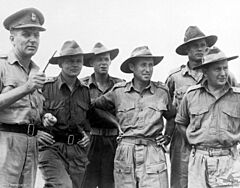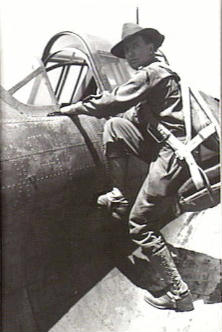Ivan Dougherty facts for kids
Quick facts for kids
Sir Ivan Noel Dougherty
|
|
|---|---|

Brigadier Ivan Dougherty, Commander 21st Brigade (centre), with Major L. E. Walcott and Captain H. M. Hamilton (right) in December 1944
|
|
| Nickname(s) | Doc |
| Born | 6 April 1907 Leadville, New South Wales |
| Died | 4 March 1998 (aged 90) Sydney, New South Wales |
| Allegiance | Australia |
| Service/ |
Australian Army |
| Years of service | 1927–1957 |
| Rank | Major General |
| Service number | NX148 |
| Commands held | 2nd Division (1952–54) 8th Brigade (1948–52) 21st Brigade (1942–45) 23rd Brigade (1942) 2/4th Battalion (1940–42) 33rd Battalion (1938–39) |
| Battles/wars | Second World War
|
| Awards | Knight Bachelor Commander of the Order of the British Empire Distinguished Service Order & Bar Efficiency Decoration Mentioned in Despatches (3) |
| Other work | Director of the New South Wales State Emergency Service Deputy Chancellor of the University of Sydney |
Major General Sir Ivan Noel Dougherty (6 April 1907 – 4 March 1998) was an important officer in the Australian Army. He served during the Second World War and the early Cold War period. He was known for his leadership and bravery.
Contents
Early Life and Education
Ivan Noel Dougherty was born on 6 April 1907 in Leadville, New South Wales. This was a small town in Australia. He went to Mudgee High School and later to Sydney Teachers College. In 1928, he started working as a teacher. He taught at Marrickville Junior Technical School.
While teaching, he also studied at the University of Sydney. He earned a degree in Economics. He continued teaching in different schools, including Tingha and Armidale.
Joining the Army Reserves
In 1926, while still a student, Dougherty joined the Sydney University Regiment. This was a part-time military unit. He became a lieutenant in 1927. He was promoted to captain in 1931.
His teaching jobs sometimes meant he had to leave his military duties. But when he moved to Armidale, he rejoined the Army. He quickly rose through the ranks. He became a major in 1938. By 1939, he was a lieutenant colonel and commanded the 33rd Infantry Battalion.
Family Life
In 1935, Ivan met Phyllis Lofts, who was also a teacher. They got married in Sydney. At that time, married women were not allowed to work as teachers. This rule changed during the Second World War. Phyllis was then able to teach again. They had five children together.
Second World War Service
When the Second World War began, Dougherty wanted to serve. He joined the Second Australian Imperial Force in 1939. He took a lower rank to become second-in-command of the 2/2nd Infantry Battalion. He was allowed to keep his higher rank as an honorary title.
In January 1940, he sailed with his battalion to the Middle East. They set up camp in Palestine.
Leading the 2/4th Battalion
In August 1940, Dougherty was given command of the 2/4th Australian Infantry Battalion. This was a New South Wales battalion. At first, his new commander, Brigadier Horace Robertson, was not happy. He wanted to choose his own leaders. But Dougherty quickly proved himself. He made a good impression.
Battles in Libya
In November 1940, Dougherty's battalion moved to Libya. They took part in a big attack called Operation Compass. The 2/4th Battalion helped capture the fortress of Tobruk. Dougherty led his troops well, even capturing an Italian general. He was careful to protect his soldiers.
Later, at Derna, his troops fought bravely against a large Italian force. They held their ground and captured many enemy soldiers. For his actions in this campaign, Dougherty received the Distinguished Service Order medal.
Greece, Crete, and Syria
In April 1940, Dougherty's battalion went to Greece. They tried to stop the German Army from advancing. This was a very difficult task. At the Battle of Vevi, his battalion had to retreat. They also fought at Thermopylae. They helped cover the withdrawal of other troops from Greece.
The battalion then went to Crete. Dougherty's men defended Heraklion against a German airborne attack. They fought hard and destroyed many German forces. But the Germans slowly gained control. It was decided to evacuate the troops. Dougherty made sure all his men were on ships before he left. Sadly, some of his men were killed when their ships were attacked by German planes. For his bravery in Greece and Crete, Dougherty was recognized a second time.
After these tough campaigns, Dougherty returned to Palestine. He received sad news about his family. The 2/4th Battalion rested and trained. In January 1942, they sailed back to Australia.
Fighting in New Guinea
When Dougherty arrived in Australia, he was promoted to brigadier. He was given command of the 23rd Infantry Brigade. He quickly worked to improve the training and morale of his new troops.
In October 1942, Dougherty was sent to Port Moresby in New Guinea. He took command of the 21st Infantry Brigade. This brigade had been through very tough fighting. Dougherty decided to use strong forces against smaller Japanese groups. This helped them defeat the enemy.
The 21st Infantry Brigade fought fiercely for Gona and nearby Japanese positions. The fighting was very costly. Many soldiers were injured or became sick. Dougherty himself got malaria. He went to a hospital in Goulburn to be near his family. For his leadership in this campaign, he received another medal bar for his Distinguished Service Order.

Dougherty rebuilt his brigade. He made sure all officers met his high standards. In July 1943, the 21st Infantry Brigade moved north again. They captured Kaiapit and then advanced into the Ramu Valley. They also captured Dumpu. Dougherty used speed and surprise to keep the enemy off balance. This helped his division complete its mission.
Dougherty broke his ankle and had to go to the hospital. He rejoined his brigade in early 1944. Soon after, his brigade was relieved and returned to Australia. For this campaign, Dougherty was recognized a third time.
Borneo Campaign
The 21st Infantry Brigade prepared for its next mission. This involved landing from the sea. Dougherty watched the invasion of Morotai to learn lessons. These lessons were used in training exercises.
Dougherty's final battle of the war was at Balikpapan on 1 July 1945. The Japanese were greatly outnumbered. But they still fought very hard. However, the Australian forces used a lot of firepower. This helped keep their casualties much lower than in earlier campaigns.
After Japan surrendered, Dougherty became the Military Governor in Makassar. He accepted the surrender of Japanese forces. He also helped process Japanese prisoners of war. He released Allied prisoners and helped distribute food and medicine to civilians. For his excellent service, Dougherty was made a Commander of the Order of the British Empire in 1947.
Life After the War
After the war, Dougherty returned to civilian life. He tried to enter politics in the 1946 election. He ran as a Liberal candidate for East Sydney. But he lost the election.
He went back to teaching in 1946. In 1948, he became an Inspector of Schools. In 1955, he left the education department. He became the first Director of the New South Wales State Emergency Service. He held this important position until he retired in 1972. He was knighted in 1968 for his service to former soldiers and the community.
Dougherty also stayed in the Army Reserves. He commanded the 8th Infantry Brigade in 1948. In 1952, he was promoted to major general. He commanded the 2nd Division. He retired from the Army in 1957.
Dougherty was also involved with the University of Sydney. He was a member of its governing body from 1954 to 1974. He served as Deputy Chancellor from 1958 to 1966. The University gave him an honorary Doctor of Laws degree in 1976.
The Ivan Dougherty Gallery at the University of New South Wales was named in his honor. This means his name is still linked to fine art today.
Ivan Dougherty passed away on 4 March 1998, after a long illness. Many people attended his funeral. Over 500 people, including about 200 soldiers who served under him, paid tribute to him.
Images for kids



